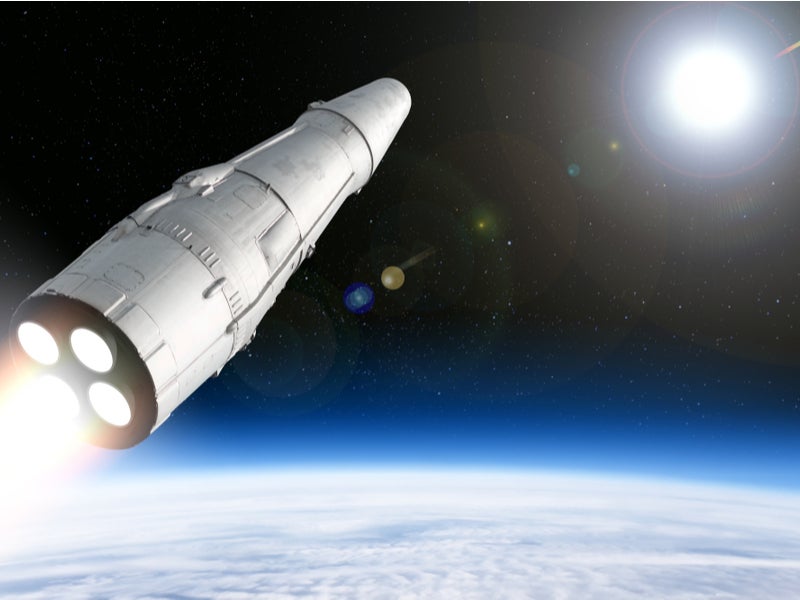A key economic advantage that hypersonic weapons could bestow is the ability to produce export versions of a product. Currently, the economic focus of the hypersonic industry is on the development and testing of weapons. This will change in the coming years as testing become more successful and the procurement stage begins. Contracts will be awarded to companies for mass production of hypersonic weapons. Current contracts are limited to either hypersonic development or subcontracts to develop or test specific materials, but as the sector expands, the diversity and quantity of contracts will increase.
Listed below are the major milestones in the hypersonic weapons industry, as identified by GlobalData.
1929 – The first liquid-fuelled rocket was launched. This launch was conducted by Dr. Robert H. Goddard who used liquid oxygen and gasoline to propel the rocket. He had obtained a patent for a rocket using liquid fuel in 1914 and is considered the father of modern rocket propulsion.
1956 – The Lockheed F-104 Starfighter flew for the first time. The Starfighter was a single-engine supersonic aircraft, at the time it was the fastest aircraft ever, and was also able to climb exceptionally high.
1958 – The X-7 reached Mach 4.3. The X-7 was an unmanned test-bed developed by Lockheed and was designed only to operate for a short time before detaching and landing without damage so it could be re-used.
1959 – The first flight of the X-15 took place. The X-15 was operated by the US Air Force, and whilst being piloted managed to fly to the edge of space. The X-15 eventually managed to achieve speeds of Mach 6.
1969 – Concorde took its first flight. Concorde was the first supersonic jet Aircraft, it could achieve speeds of Mach 2.4 and could cross the Atlantic in four hours. Concorde stopped flying after a major crash in 2003.
How well do you really know your competitors?
Access the most comprehensive Company Profiles on the market, powered by GlobalData. Save hours of research. Gain competitive edge.

Thank you!
Your download email will arrive shortly
Not ready to buy yet? Download a free sample
We are confident about the unique quality of our Company Profiles. However, we want you to make the most beneficial decision for your business, so we offer a free sample that you can download by submitting the below form
By GlobalData1964-1998 – The SR-71 Blackbird attained speeds of Mach 3. The SR-71 was an aircraft developed by Lockheed as part of a classified project. It was designed to operate at high speeds and altitudes in order to evade threats.
2004 – Nasa successfully flew an X-43A using a scramjet engine, the flight only lasted 10 seconds but also included a 10-minute glide period
2004 – Russia tested its first hypersonic vehicle. The UR-100N UTTH was an improved version of the UR-11N which was in use with the Soviet Union and had hypersonic capability.
2007 – Project Blackswift was commissioned by DARPA. This project was developed with the aim of creating a reusable unmanned hypersonic device, which was projected to reach Mach 6. However, this project was cancelled in 2009.
2008 – The Pentagon used funding from its prompt global strike program to fund a hypersonic glide vehicle, which it planned to attach to a ballistic missile to achieve hypersonic speeds on re-entry.
2011 – There was a failed attempt by DARPA to produce a vehicle that could reach Mach 20. The HTV-2 was an experimental hypersonic glide vehicle, but after multiple test failures, DARPA shelved the design.
2013 – Boeing’s X-51 Waverider was successfully flown. This was an unmanned vehicle capable of reaching speeds of Mach 5 and the technology may be utilised for hypersonic weapons.
2016 – Russia conducted the first test of its Avangard missile, an advanced hypersonic weapon.
2016 – China successfully tested the DF-ZF, a hypersonic missile with a potential speed of Mach 10.
2018 – Russia tested the hypersonic ‘Khinzal’ (Dagger) missile, and released a video of the missile being launched from a MiG-31 fighter jet.
2019 – Russia deployed the Avangard Missile, which it claims can travel at speeds of Mach 27 and hit targets up to 6,000km away.
2020 – The High-Speed Strike Weapon (HSSW) was cancelled, with the US shifting focus to the Air-Launched rapid response weapon (ARRW) which is capable of speeds of up to Mach 20.
2023 – The LRHW is scheduled to be ready for deployment, a program which is being delivered by Lockheed
2023 – ARRW missiles are scheduled to be ready for deployment; they are currently in development by Lockheed.
2028 – The CPS is scheduled to be ready for deployment, this is a program that is currently in development by Lockheed and will be deployed on Virginia-class submarines.
2040 – Both Boeing and Hermeus have stated that they could potentially have functioning hypersonic commercial technology, though this is the earliest possible date.
This is an edited extract from the Hypersonic Technologies – Thematic Research report produced by GlobalData Thematic Research.










Related Company Profiles
Boeing China Inc
Airforce
Pentagon Limited
C.P.S. SpA
Concorde Inc.